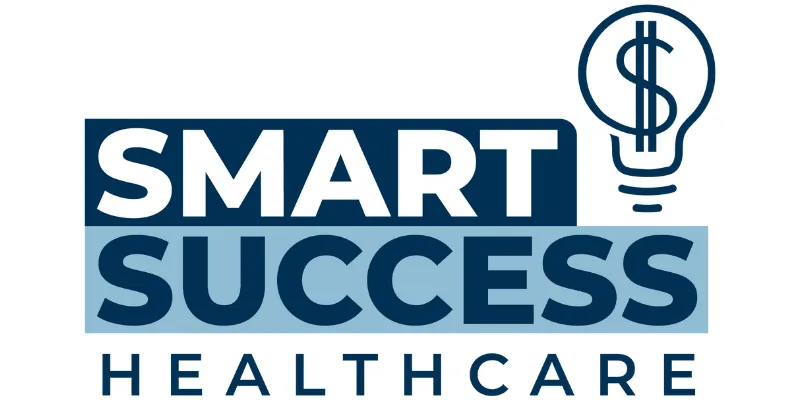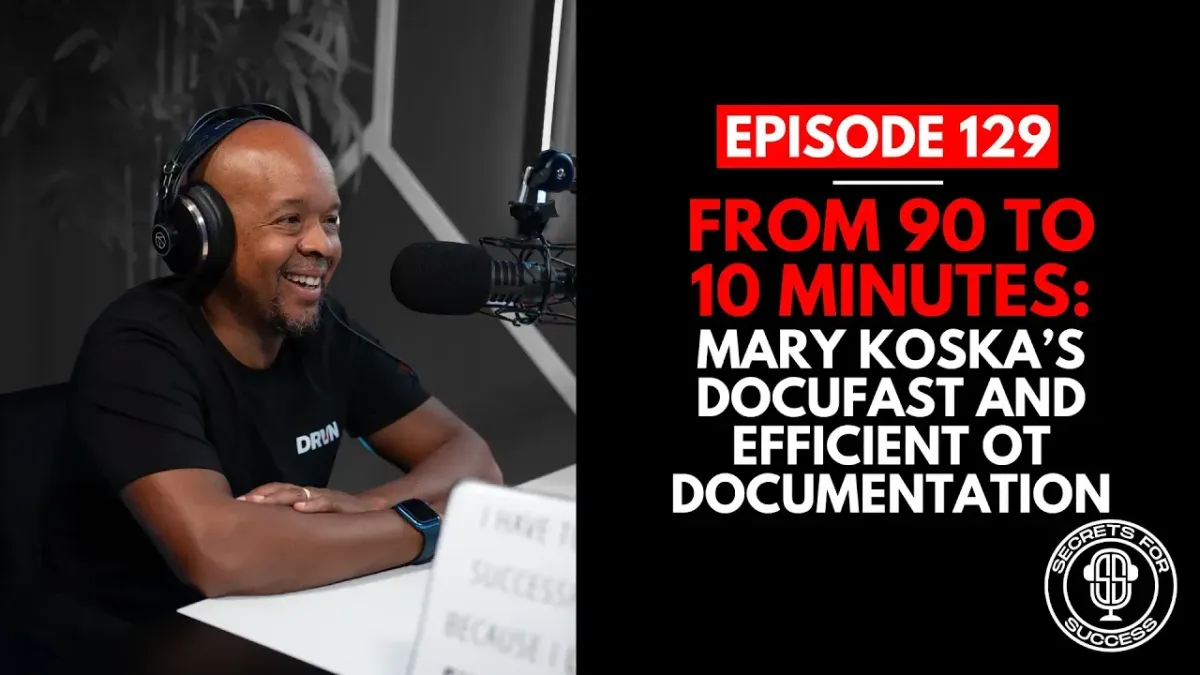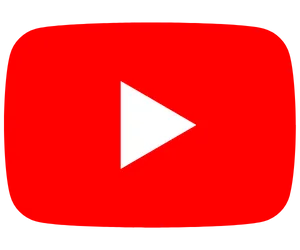
BLOG

From 90 to 10 Minutes: Mary Kostka’s Docufast and Efficient OT Documentation
Streamlining Occupational Therapy Documentation: Insights from Mary Kostka
In the latest episode of SSHC, host Greg Todd sits down with Mary Kostka to discuss her incredible journey in revolutionizing documentation practices within pediatric occupational therapy. Mary, the force behind Ohana OT and the Docufast program, reflects on her once-dreaded documentation process and how she turned it into a streamlined system beneficial not only for her clinic but also for practice owners across the board. Through perseverance, innovation, and a constant eye for efficiency, Mary has found ways to reduce evaluation times from a staggering 90 minutes to a mere 10 minutes without compromising quality. This post delves into her journey and shares critical insights for improving documentation efficiency in occupational therapy.
From Frustration to Proficiency: Mary's Documentation Journey
Initially, Mary Kostka did not enjoy the documentation aspect of pediatric occupational therapy. However, her perfectionist nature drove her to master it, and in doing so, she found a way to make it less tedious and more efficient. She developed her documentation system to solve her issues, ensuring the quality and audit readiness of all reports.
Mary's turning point came during the pandemic when she discovered through a Facebook group that many professionals struggled with documentation. This revelation spurred her to share her knowledge, eventually leading to the creation of the Docufast program. This program has been a game-changer for numerous practice owners, slashing their evaluation times and significantly improving their operational efficiency.
Streamlining Documentation: Less is More
One of the core issues Mary addresses is the tendency of pediatric occupational therapists to over-educate and detail their evaluations. Long, exhaustive reports, though well-intentioned, often overwhelm parents and caregivers. Mary proposes an alternative education method: providing educational handouts over the first four to six weeks of therapy instead of bombarding caregivers with information all at once. This approach allows for a more gradual and manageable learning curve.
Efficiency in documentation is not just about cutting down time but also about maintaining relevance. By creating shorter, more focused reports using a rubric with specific elements (such as measurable progress and clear therapist interventions), Mary emphasizes that quality does not have to correlate with length. This strategy ensures that the documentation remains clear, concise, and useful.
Overcoming Implementation Challenges
Introducing new documentation strategies can be challenging since many practitioners fear deviating from established methods or worry about appearing unprofessional. Mary notes that successful implementation begins with leadership. Leaders must set clear expectations, support their teams, and address fears and concerns methodically.
Changing the mindset around documentation is crucial. Greg Todd shares a common sentiment that reducing documentation time may imply lower quality of care. Mary counters this by arguing that streamlined documentation allows more time for patient interaction and focused therapy, ultimately enhancing care quality.
The Financial Implications of Inefficient Documentation
Mary vividly outlines the financial losses caused by inefficient documentation processes. It's not limited to documentation time itself but extends to staff turnover and recruitment costs. The minimum cost for hiring a new therapist, including relocation and sign-on bonuses, can be upwards of $20,000, and lost revenue can reach $8,000 per month during the vacancy period. Efficient documentation practices can significantly reduce these costs, saving clinics between $30,000 to $100,000 annually.
Moreover, a productive therapist can generate up to $100,000 annually beyond their employment cost, emphasizing the importance of retaining staff. Documentation inefficiency is a known factor in causing burnout and turnover, making an efficient system key to maintaining a stable workforce.
Building a Positive Work Culture
Mary extends her documentation efficiency principles to overall clinic management by fostering a supportive and enjoyable work environment. Her clinic emphasizes staff retention through efficient workflows ensuring no take-home work, which is essential for preventing burnout. Utilizing support staff for non-specialist tasks allows therapists to focus on their essential duties without being overwhelmed.
Mary also implements unique strategies like daily check-ins, peer reviews, and framed affirmations to boost morale and address any frustrations before they escalate. The clinic’s 4-day, 10-hour work schedule allows for three-day weekends, catering to a work-life balance that enhances staff satisfaction.
Conclusion
Mary Kostka's journey from disliking documentation to becoming a pioneer in documentation efficiency illustrates the profound impact of streamlined practices on clinic operations and staff well-being. Her Docufast program has proven that shorter, focused, and efficient documentation not only saves time but also enhances the quality of care. By addressing both the financial and emotional aspects of documentation practices, Mary provides a roadmap for clinics to follow. Investing in efficient systems and staff is key to creating a sustainable and positive work culture, ultimately leading to better patient outcomes and a thriving practice.
Watch Greg Todd's Video on From 90 to 10 Minutes: Mary Kostka’s Docufast and Efficient OT Documentation
Follow Greg on Socials:
https://www.Instagram.com/gregtoddpt
https://www.Facebook.com/gregtoddpt

From 90 to 10 Minutes: Mary Kostka’s Docufast and Efficient OT Documentation
Streamlining Occupational Therapy Documentation: Insights from Mary Kostka
In the latest episode of SSHC, host Greg Todd sits down with Mary Kostka to discuss her incredible journey in revolutionizing documentation practices within pediatric occupational therapy. Mary, the force behind Ohana OT and the Docufast program, reflects on her once-dreaded documentation process and how she turned it into a streamlined system beneficial not only for her clinic but also for practice owners across the board. Through perseverance, innovation, and a constant eye for efficiency, Mary has found ways to reduce evaluation times from a staggering 90 minutes to a mere 10 minutes without compromising quality. This post delves into her journey and shares critical insights for improving documentation efficiency in occupational therapy.
From Frustration to Proficiency: Mary's Documentation Journey
Initially, Mary Kostka did not enjoy the documentation aspect of pediatric occupational therapy. However, her perfectionist nature drove her to master it, and in doing so, she found a way to make it less tedious and more efficient. She developed her documentation system to solve her issues, ensuring the quality and audit readiness of all reports.
Mary's turning point came during the pandemic when she discovered through a Facebook group that many professionals struggled with documentation. This revelation spurred her to share her knowledge, eventually leading to the creation of the Docufast program. This program has been a game-changer for numerous practice owners, slashing their evaluation times and significantly improving their operational efficiency.
Streamlining Documentation: Less is More
One of the core issues Mary addresses is the tendency of pediatric occupational therapists to over-educate and detail their evaluations. Long, exhaustive reports, though well-intentioned, often overwhelm parents and caregivers. Mary proposes an alternative education method: providing educational handouts over the first four to six weeks of therapy instead of bombarding caregivers with information all at once. This approach allows for a more gradual and manageable learning curve.
Efficiency in documentation is not just about cutting down time but also about maintaining relevance. By creating shorter, more focused reports using a rubric with specific elements (such as measurable progress and clear therapist interventions), Mary emphasizes that quality does not have to correlate with length. This strategy ensures that the documentation remains clear, concise, and useful.
Overcoming Implementation Challenges
Introducing new documentation strategies can be challenging since many practitioners fear deviating from established methods or worry about appearing unprofessional. Mary notes that successful implementation begins with leadership. Leaders must set clear expectations, support their teams, and address fears and concerns methodically.
Changing the mindset around documentation is crucial. Greg Todd shares a common sentiment that reducing documentation time may imply lower quality of care. Mary counters this by arguing that streamlined documentation allows more time for patient interaction and focused therapy, ultimately enhancing care quality.
The Financial Implications of Inefficient Documentation
Mary vividly outlines the financial losses caused by inefficient documentation processes. It's not limited to documentation time itself but extends to staff turnover and recruitment costs. The minimum cost for hiring a new therapist, including relocation and sign-on bonuses, can be upwards of $20,000, and lost revenue can reach $8,000 per month during the vacancy period. Efficient documentation practices can significantly reduce these costs, saving clinics between $30,000 to $100,000 annually.
Moreover, a productive therapist can generate up to $100,000 annually beyond their employment cost, emphasizing the importance of retaining staff. Documentation inefficiency is a known factor in causing burnout and turnover, making an efficient system key to maintaining a stable workforce.
Building a Positive Work Culture
Mary extends her documentation efficiency principles to overall clinic management by fostering a supportive and enjoyable work environment. Her clinic emphasizes staff retention through efficient workflows ensuring no take-home work, which is essential for preventing burnout. Utilizing support staff for non-specialist tasks allows therapists to focus on their essential duties without being overwhelmed.
Mary also implements unique strategies like daily check-ins, peer reviews, and framed affirmations to boost morale and address any frustrations before they escalate. The clinic’s 4-day, 10-hour work schedule allows for three-day weekends, catering to a work-life balance that enhances staff satisfaction.
Conclusion
Mary Kostka's journey from disliking documentation to becoming a pioneer in documentation efficiency illustrates the profound impact of streamlined practices on clinic operations and staff well-being. Her Docufast program has proven that shorter, focused, and efficient documentation not only saves time but also enhances the quality of care. By addressing both the financial and emotional aspects of documentation practices, Mary provides a roadmap for clinics to follow. Investing in efficient systems and staff is key to creating a sustainable and positive work culture, ultimately leading to better patient outcomes and a thriving practice.
Watch Greg Todd's Video on From 90 to 10 Minutes: Mary Kostka’s Docufast and Efficient OT Documentation
Follow Greg on Socials:
https://www.Instagram.com/gregtoddpt
https://www.Facebook.com/gregtoddpt
Join us on our Social Media
platforms to learn and grow with Smart Success Healthcare
We help Physical Therapists, Occupational Therapists, Dietitians and Chiropractors achieve multi 6 to 7 figures per month with few staff, happy patients and great results!

Text us at 813-534-6453 or
© 2025 Smart Success Healthcare







